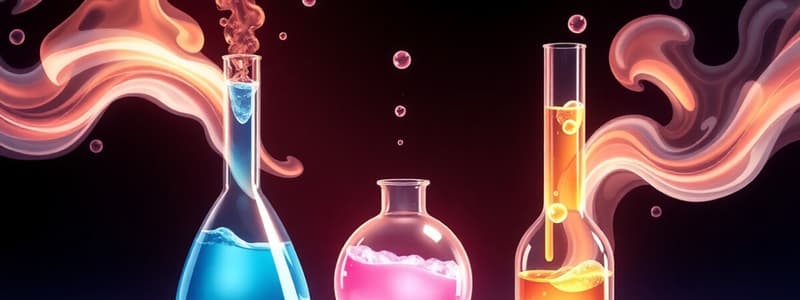Podcast
Questions and Answers
In the experiment involving the explosion of methane and ethane mixture with oxygen, what is the role of potassium hydroxide solution?
In the experiment involving the explosion of methane and ethane mixture with oxygen, what is the role of potassium hydroxide solution?
- It absorbs the unreacted oxygen.
- It absorbs carbon dioxide formed during the explosion. (correct)
- It neutralizes any acidic impurities in the gas mixture.
- It catalyzes the explosion reaction.
What is the significance of maintaining constant pressure throughout the experiments involving gas explosions and volume measurements?
What is the significance of maintaining constant pressure throughout the experiments involving gas explosions and volume measurements?
- It allows for the direct comparison of gas volumes, as volume changes are solely due to the number of moles of gas. (correct)
- It ensures that the amount of heat released during the reaction is constant.
- It simplifies the calculation of gas densities.
- It prevents any loss of gas due to leaks in the apparatus.
In the analysis of producer gas, what is the purpose of treating the gas sample with potassium hydroxide solution?
In the analysis of producer gas, what is the purpose of treating the gas sample with potassium hydroxide solution?
- To remove nitrogen gas.
- To remove carbon monoxide.
- To convert carbon monoxide to carbon dioxide.
- To remove carbon dioxide. (correct)
When a mixture of carbon monoxide and carbon dioxide is exploded with excess oxygen, what does the first contraction of 30 cm³ primarily indicate?
When a mixture of carbon monoxide and carbon dioxide is exploded with excess oxygen, what does the first contraction of 30 cm³ primarily indicate?
In the experiment with methanol, propene, and methane, why is the mixture cooled back to 75°C after ignition?
In the experiment with methanol, propene, and methane, why is the mixture cooled back to 75°C after ignition?
If, in the methane and ethane explosion experiment, the initial volume of the mixture was doubled, and the volume of oxygen was also doubled, how would you expect the volume decrease after treatment with potassium hydroxide to change, assuming complete combustion?
If, in the methane and ethane explosion experiment, the initial volume of the mixture was doubled, and the volume of oxygen was also doubled, how would you expect the volume decrease after treatment with potassium hydroxide to change, assuming complete combustion?
Consider a scenario where the potassium hydroxide solution used in the experiments is replaced with an equal volume of sodium hydroxide solution of the same concentration. How would this change affect the results?
Consider a scenario where the potassium hydroxide solution used in the experiments is replaced with an equal volume of sodium hydroxide solution of the same concentration. How would this change affect the results?
In the producer gas analysis, if the initial treatment with potassium hydroxide resulted in no volume change, what could be confidently inferred about the composition of the producer gas?
In the producer gas analysis, if the initial treatment with potassium hydroxide resulted in no volume change, what could be confidently inferred about the composition of the producer gas?
In the experiment involving carbon monoxide, methane, and hydrogen, what is the purpose of adding excess oxygen before the explosion?
In the experiment involving carbon monoxide, methane, and hydrogen, what is the purpose of adding excess oxygen before the explosion?
If the cooling step after the explosion of the methanol, propene, and methane mixture were omitted, how would the calculated composition of the original mixture be affected?
If the cooling step after the explosion of the methanol, propene, and methane mixture were omitted, how would the calculated composition of the original mixture be affected?
A mixture of $CH_4$ and $C_2H_6$ with a total volume of 60 cm³ is exploded with excess $O_2$. After cooling, the volume decreases by 80 cm³ upon treatment with $KOH$. What's the volume of $CH_4$ in the original mixture?
A mixture of $CH_4$ and $C_2H_6$ with a total volume of 60 cm³ is exploded with excess $O_2$. After cooling, the volume decreases by 80 cm³ upon treatment with $KOH$. What's the volume of $CH_4$ in the original mixture?
A mixture of $CO$ and $CO_2$ is exploded with excess $O_2$. A contraction of 40 cm³ is observed. Subsequent shaking with $NaOH$ causes a further contraction of 75 cm³. What percentage of the original mixture was $CO$?
A mixture of $CO$ and $CO_2$ is exploded with excess $O_2$. A contraction of 40 cm³ is observed. Subsequent shaking with $NaOH$ causes a further contraction of 75 cm³. What percentage of the original mixture was $CO$?
Producer gas (180 cm³, $CO$, $N_2$, $CO_2$) becomes 175 cm³ after treatment with $KOH$. The resulting gas, when exploded with just enough $O_2$, gives a mixture which diminishes by 60 cm³ upon treatment with $KOH$, leaving 115 cm³ of undissolved gas. What is the percentage of $N_2$?
Producer gas (180 cm³, $CO$, $N_2$, $CO_2$) becomes 175 cm³ after treatment with $KOH$. The resulting gas, when exploded with just enough $O_2$, gives a mixture which diminishes by 60 cm³ upon treatment with $KOH$, leaving 115 cm³ of undissolved gas. What is the percentage of $N_2$?
A 70 cm³ mixture of $CH_3OH$, $C_3H_6$, and $CH_4$ is mixed with oxygen and ignited. Cooling contracts the volume by 125 cm³, and $KOH$ treatment further contracts it by 90 cm³. What is the original volume of $CH_3OH$?
A 70 cm³ mixture of $CH_3OH$, $C_3H_6$, and $CH_4$ is mixed with oxygen and ignited. Cooling contracts the volume by 125 cm³, and $KOH$ treatment further contracts it by 90 cm³. What is the original volume of $CH_3OH$?
If the experiment involving methane and ethane were conducted at a higher temperature, but still below the boiling point of water, how would the volume decrease after treatment with $KOH$ be affected?
If the experiment involving methane and ethane were conducted at a higher temperature, but still below the boiling point of water, how would the volume decrease after treatment with $KOH$ be affected?
Given the reaction $CO + 0.5 O_2 \rightarrow CO_2$. If $50 cm^3$ of $CO$ reacts completely with $O_2$. What volume of $CO_2$ is produced, assuming constant temperature and pressure?
Given the reaction $CO + 0.5 O_2 \rightarrow CO_2$. If $50 cm^3$ of $CO$ reacts completely with $O_2$. What volume of $CO_2$ is produced, assuming constant temperature and pressure?
In the reaction $CH_4 + 2O_2 \rightarrow CO_2 + 2H_2O$, if $60 cm^3$ of $CH_4$ reacts completely, and the water vapor is condensed, what volume is reduced after the reaction?
In the reaction $CH_4 + 2O_2 \rightarrow CO_2 + 2H_2O$, if $60 cm^3$ of $CH_4$ reacts completely, and the water vapor is condensed, what volume is reduced after the reaction?
In the context of the experiments described, what is the limiting reactant if 100 cm³ of methane ($CH_4$) is mixed with 150 cm³ of oxygen ($O_2$)?
In the context of the experiments described, what is the limiting reactant if 100 cm³ of methane ($CH_4$) is mixed with 150 cm³ of oxygen ($O_2$)?
What would be the major implication if the volume measurements were not conducted under the same temperature and pressure?
What would be the major implication if the volume measurements were not conducted under the same temperature and pressure?
Flashcards
KOH solution's effect?
KOH solution's effect?
Potassium hydroxide solution removes carbon dioxide from a gas mixture.
Producer gas contains?
Producer gas contains?
A mixture of carbon monoxide, nitrogen, and carbon dioxide.
Gas composition calculation?
Gas composition calculation?
Determine the composition by volume of a gas mixture after reactions, using volume changes and gas properties.
Why volume contraction?
Why volume contraction?
Volume decreases due to the consumption of gases during the reaction to form liquid water
Signup and view all the flashcardsStudy Notes
Calculations Involving Volumes of Gases
- 48 cm3 of methane and ethane mixture was exploded with 180 cm3 of oxygen.
- After cooling to room temperature, the volume of residual gas was noted.
- The volume decreased by 64 cm3 after treatment with potassium hydroxide solution.
- The composition by volume of the original mixture is 32 cm3 methane and 16 cm3 ethane.
- 160 cm3 of carbon monoxide, methane, and hydrogen mixture was exploded with 250 cm3 of oxygen.
- After cooling, the volume of residual gas was reduced by 110 cm3 when shaken with potassium hydroxide solution.
- 80 cm3 of excess oxygen remained.
- The composition by volume of the original mixture is 50 cm3 carbon monoxide, 60 cm3 methane, and 50 cm3 hydrogen.
- A mixture of carbon monoxide and carbon dioxide was exploded with excess oxygen, resulting in a 30 cm3 contraction.
- An additional 65 cm3 contraction occurred after shaking the residual gas with sodium hydroxide solution.
- The original mixture's percentage composition by volume is 92.3% carbon monoxide and 7.7% carbon dioxide.
- 150 cm3 of producer gas (carbon monoxide, nitrogen, and carbon dioxide) became 147 cm3 when treated with potassium hydroxide solution.
- The explosion of the resulting gas with sufficient oxygen produced a mixture of gases.
- The mixture's volume decreased by 46.5 cm3 after treatment with potassium hydroxide solution, leaving 100.5 cm3 of undissolved gas.
- The percentage composition by volume of the producer gas is 2% carbon dioxide, 31% carbon monoxide, and 67% nitrogen.
- 60 cm3 of gaseous mixture (methanol, propene, methane) was mixed with 325 cm3 of oxygen and ignited.
- After cooling to 75°C, the mixture contracted by 115 cm3.
- An additional 80 cm3 contraction occurred on treatment with potassium hydroxide solution.
- The resulting composition by volume of the original mixture consists of 20 cm3 methanol, 10 cm3 propene, and 30 cm3 methane.
Studying That Suits You
Use AI to generate personalized quizzes and flashcards to suit your learning preferences.




